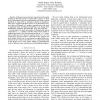Free Online Productivity Tools
i2Speak
i2Symbol
i2OCR
iTex2Img
iWeb2Print
iWeb2Shot
i2Type
iPdf2Split
iPdf2Merge
i2Bopomofo
i2Arabic
i2Style
i2Image
i2PDF
iLatex2Rtf
Sci2ools
83
Voted
INFOCOM
2007
IEEE
2007
IEEE
Optimal-Complexity Optical Router
—In the past years, electronic routers have had trouble keeping up with the increase in optical fiber capacity. As their power consumption has grown exponentially and already exceeds standards, it seems that an alternative solution is mandatory. Many have suggested all-optical routers as an alternative. However, these are deemed too complex, especially given the need to implement both switching and buffering, even though their fundamental complexity has apparently never been analyzed. In this paper, we study the number of fundamental optical components (2 × 2 switches and fiber delay lines) needed to emulate ideal routers. We first demonstrate that an N ×N router with a buffer size of B per port needs at least Θ(N log(NB)) components, and then build a construction that achieves this lower bound. On the way, we also present an optical buffer construction of size B that works with Θ(log(B)) components, which is also shown to be a lower bound. Finally, we generalize this result t...
Related Content
| Added | 03 Jun 2010 |
| Updated | 03 Jun 2010 |
| Type | Conference |
| Year | 2007 |
| Where | INFOCOM |
| Authors | Hadas Kogan, Isaac Keslassy |
Comments (0)

